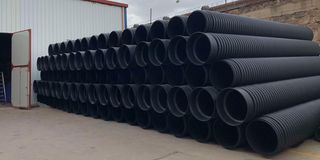Improved pipes a solution to the country’s perennial poor drainage problem

High-density polyethene (HDPE), Double walled corrugated (DWC), commonly known as HDPE DWC, is a new technology of pipes being used to build drainages.
Heavy rains are usually not a blessing, not just in Nairobi, but in the country’s other counties. And non-existent or poor drainage systems are to blame in many cases.
As it is, whenever it rains heavily, Kenyans are forced to wade through pools of water, some of it polluted by raw sewage, while in some parts of the country, rivers sweep away bridges or flood roads, making them impassable. In others, houses are swept away or submerged by mudslides.
The problem of flooding is a perennial one, even in cities where, ideally, the drainage system should be efficient.
The most affected areas are populated inner-city estates, especially slum areas where open drainage channels combine rainwater and debris, leading to blockage.
Efforts by the Kenya Urban Roads Authority to have in place roadside drainage systems in the past have been in vain as some of these drains are chockful with solid waste such as ballast and sand left behind following construction.
There is, however, a solution to this menace in form of pipes known as High-density polyethene (HDPE), Double walled corrugated (DWC), commonly known as HDPE DWC.
Kirin Pipes is a leading manufacturer of these pipes. Chris Mwangi, the technical sales manager at the company, says the HDPE DWC Pipes anchor Vision 2030 as they provide affordable and sustainable controlling of wastewater and sanitation services.
Mwangi explains that the pipes were introduced in the East African market to replace precast concrete pipes.
Popular option
They are a top piping preference in Asia, Europe and North America and are fast replacing past systems such as concrete, clay piping and fibreglass due to their excellent performance levels.
“Corrugation on the outer wall to increase stiffness and smooth in the inside for a better flow makes the pipes unique,” he notes.
The DWC Pipes are manufactured from Polyethylene material, which is the most stable plastic, hence does not react with the toxic and chemical wastes flowing in sewage as compared to other plastics.

High-density polyethene (HDPE), Double walled corrugated (DWC), commonly known as HDPE DWC, is a new technology of pipes being used to build drainages.
Double Wall Corrugated pipes are corrosion-resistant to acids, bases and salts. The pipes are produced at a standard length of 6 meters, compared to concrete pipes traditionally cast at a maximum length of 1.2 meters.
This, therefore, means that jointing work is greatly reduced within a specified span, reducing the probability of leakages.
The DWC pipes are lightweight compared to concrete, a factor that cuts down on the cost of labour, installation and transportation. Construction time and project delivery are also reduced.
Further, the lightweight feature of these pipes means they have exceptional mechanical properties such as high ring stiffness, impact strength and a crush resistance that is high. They also have the ability to hold out weighty external loads when properly buried and backfilled.
“The Pipes have excellent flow characteristics because they are smoother than concrete, meaning that there is less drag and low tendency of turbulence at high flow. The non-stick surface almost eliminates scaling and pitting, rendering the pipe to longer service life - HDPE generally has a lifespan of up to 50 years compared to concrete pipes which last up to 20 years,” says Mwangi.
Uses
On usage, the HDPE DWC pipes are mainly used in buried drainage, sewerage discharge, communication cable casing, farmland water conservancy (canals) and other non-pressurised wastewater applications.
These pipes have been adopted by various agencies in the Ministry of Water and Sanitation to address the problems of inadequate sewer infrastructure in urban areas and expansion into metropolitan settlements outside the urban areas.
The outcome has been positive because there is growing access to sanitation services and more effective drainage systems than before.
This new technology of pipes can be easily installed since they are longer and can be bent to a radius 25 times the nominal pipe diameter, which makes them cost-effective, unlike other pipes which need additional readjustments such as restraints, thrust blocks and glued fittings.
They are also easy to connect and quickly constructed. The pipes are suitable in areas prone to landslides and do well in crowded areas with bad geology since such an area has a high ground water level and a loose foundation, therefore, when buried properly and backfilled, the pipes have the ability to hold out weighty external loads.
“In developed nations, infra-red cameras are installed inside the DWC pipes to capture flow rate and volume of wastewater being channelled out of municipalities. With such information, planning and improvement of wastewater management in urban areas is easier since it is data-driven,” he adds.
“It is also important to note that in the case of communication cable casing, once the pipes have been installed and cables are running on the inside, whenever there is an upgrade in the communication systems, old cables are retracted while new ones are placed without unearthing of road paths, cabros on walkways and road-crossings, saving on restoration costs and preservation of existing infrastructure and less disruption to the environment,” he remarks.
The HDPE pipes come in handy to industries, municipalities and urban establishments that look to efficiently manage their rainwater and wastewater, which when haphazardly unmaintained, can be detrimental to the environment.





